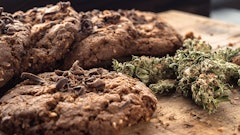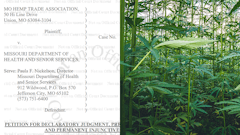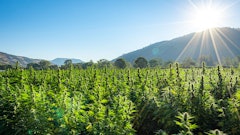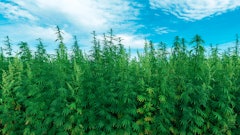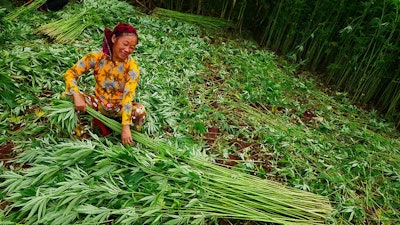
Hmong hemp culture spreads across a region shared by present-day southwestern China and northernmost Thailand, Laos and Vietnam. For centuries, women of the Hmong ethnic minority have cultivated hemp to weave linen (plain weave) fabrics. And today, they preserve their traditional methods of growing and preparing hemp fibers for weaving into fine fabric by using very few tools.
Growing Flexible Fiber
The Hmong of northern Vietnam are surrounded by breathtakingly beautiful limestone mountains covered in lush greenery, creating a place where hemp crops thrive due to the high altitude, warm temperatures and frequent rain and sun.
Hemp linen fabric made from long, thin, and flexible fibers is not only durable and stain-resistant but also suited for storage in humid conditions without molding. These are important features in a self-sufficient, mountainous region, where it rains often.
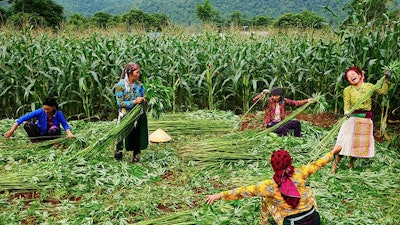
Hmong women harvesting hemp, used for both everyday and ceremonial linens in Vietnam. Photo by Git Skoglund
Hang Thi is one of the skillful Hmong women who cultivates fine hemp fibers to weave into yarns and fabrics. She learned how to cultivate and process hemp from her mother and grandmother—knowledge that has been passed down through generations.
“In this environment, hemp develops flexible fibers and usually does not need any added nutrients when growing,” Hang Thi says. In temperate northern Vietnam, winter floods create a clay sediment mixed with lime that enriches the soil. Cultivators then use buffalo manure (or animal dung) to fertilize the land before planting seeds in mid-March during the spring rains.
Hang Thi says families in northern Vietnam often cultivate hemp fiber in gardens near their homes, which are usually sheltered within corn fields to protect the crop from strong winds. Growers also sow the seeds densely to ensure the stalks elongate rapidly while remaining thin.
“The seeds must be sown closely together so that the stalks do not become too coarse,” Hang Thi says. “And it is important to harvest just before the plants begin to flower.”
She adds that harvesting juvenile plants can preclude developmental differences between males and females and yield uniformly high-quality fiber, and that stalks should not grow to more than 160 centimeters (about 5 feet) in height. “By following these simple steps, we grow strong, fine and flexible fiber,”
On the Ground
When we visited Vietnam’s Ha Giang province in mid-June 2022, the hemp fields were being harvested during a break in the rainy weather. Cultivators typically manually harvest hemp fiber crops by cutting off the stalks with a sickle—a tool commonly used to harvest rice.
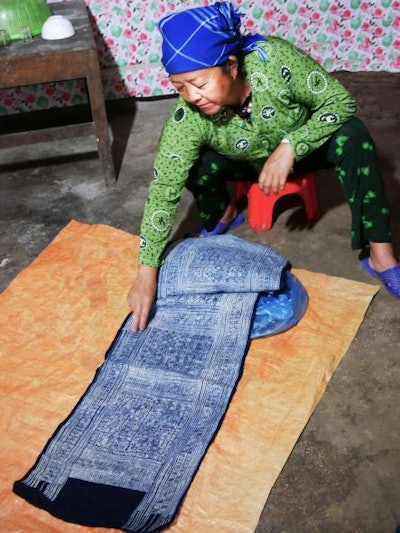

Hang Thi. Photo by Git Skoglund
Hang Thi showed us that the hemp stalks are divided into three groups based on their diameter and height: shortest, medium height and tallest. She adds that stalks in each group are utilized differently. The thinnest and shortest are reserved for the finest yarn, and the longest and thickest are used for coarser yarn.
European hemp fiber processing differs from that of traditional Asian cultures. The traditional European processing strategy is to either field- or water-ret the stalks, followed by drying, mechanical crushing, scutching (beating the fiber to remove woody shives) and hackling (to further clean and straighten the fibers) to produce fibers suitable for hand spinning from a distaff with either a drop spindle or spinning wheel. Hackling produces longer line fibers while combing away shorter tow fibers of differing qualities.
Traditional Asian hemp fiber processing, on the other hand, is performed manually by cultivators using few textile tools.
Asian hemp farmers typically pound the parallel bark strips peeled from the stalks, which are bundled together, in a wooden mortar to soften them before manually splitting them into uniformly narrow strips, which are then combed vigorously at their ends with a hair comb before joining them end-to-end to form yarns. Then, the farmers twist the raw yarns to secure the joins connecting the bark strips before further softening the fibers in the mortar. This ancient yarn-making technique is simple, as no retting and few tools are needed. This may also have been used in Europe long ago, but it is, of course, time consuming.
With the Asian debarking method, only long fiber bundles are extracted from the stalks, and no shorter tow fibers are produced. Together, with harvesting juvenile hemp plants before flowering, this manual method offers a way of making very thin yarn suitable for weaving fine linen with very little waste.
Because the Hmong harvest the entire fiber field before the flowering stage, it is difficult to determine which plants are males or females. Therefore, they also sow a few plants at the homestead near the vegetable gardens to allow the male plants to flower and pollinate the females, which then develop seeds for the next growing season.
Unlike the hemp in the fiber fields, plants that will produce seed are sown more sparsely with the aim of promoting branching and producing abundant seeds. The female plants look more like a bush or even a small tree. Each female can produce more than a liter (about 1 quart) of seeds, which are either harvested in October or remain on the plant until spring. After the seeds have been picked, the plant is cut down and the coarse stem is used for firewood.
Field to Fashion
Hang Thi says a primary reason Hmong women continue to cultivate hemp is to make their standard deeply pleated skirts, which are traditionally given as wedding gifts.
In preparation for marriage, the groom's mother weaves the cloth and sews a plain white skirt and an indigo-dyed batik skirt for her future daughter-in-law. The richly patterned indigo batik skirts are often embellished with embroideries and appliqués in bright colors and are worn for market days or festivities such as weddings. The white skirt may be worn during hemp harvest and at funerals.
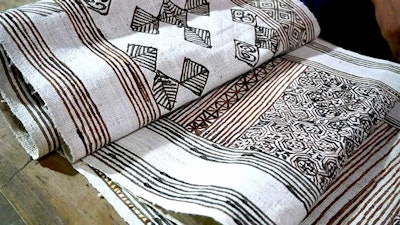
Hemp linen fabric with painted waxbatik. Photo by Git Skoglund
Hmong skirts are fashioned from two pieces of hemp linen fabric that are 5 to 7 meters (16 to 23 feet) in length and 30 centimeters (about 1 foot) wide, which are sewn together horizontally along the selvage edges. The skirts are tightly folded to create dozens of sharp pleats, symbolizing hills and valleys related to their mythological world.
During our interview, Hang Thi also showed us a roll of indigo batik-patterned hemp linen that she made herself and pointed to a square pattern that represents a hemp field with a water well in the center. The fabric’s other designs depicted cherry trees, where varying pairs of leaves symbolize loving couples.
“If you want to have a long and happy life, then you should sew a pillow from a fabric like this and sleep well on it,” Hang Thi says with a laugh.
Hemp fields in Vietnam are often small, since families also rely on their cultivated land to supply grains and other produce. Typically, fields are not larger than 30 square meters (about 325 square feet). Although small, these fields can produce enough hemp to weave 30 meters (almost 100 feet) of cloth, which is enough material to sew two pleated skirts.
“Previously, we had no money to buy textiles, so we grew hemp and made our own,” Hang Thi says. She added that there is also a need for sustainable and ecological textile material, which has helped contribute to the persistence of hemp cultivation in Vietnam.
While hemp production in the region started as a means of self-reliance, it has grown to bring more economic benefits to the area as well. Consumers are eager to buy traditionally produced, yet relatively expensive, hemp linen, which has incentivized local production, Hang Thi says. “Not only [do] tourists want to buy our hemp linen, but also big companies, like airlines in Vietnam, [want to as well]. They use our fabric to cover the head cushions of the business class seats,” Hang Thi says.
Several textile cooperatives have been formed in Vietnam, which the federal government supports in various ways, including participating in craft fairs and other events aimed at international buyers. One of the biggest cooperatives is situated near Hang Thi’s village. The cooperative was started by Mai Vàng Thi, another progressive Hmong woman who has received several awards for her engagement in producing traditional hemp linen for commercial sales. (Both young and old women usually work together—the younger women debark the stalks, while the older women comb the bast bundles and splice the yarn.)
The impetus for Hmong women’s preservation of their textile hemp tradition, however, is not only economic. Throughout East Asia, hemp is strongly associated with the shamanic symbolism of myths and legends and is linked with concepts of purity and ritual purification, as well as providing personal protection. Both men and women appreciate their hemp clothes in everyday life, and the women proudly wear their iconic knee-length pleated skirts. When a Hmong woman is to be buried, she will be dressed in her best hemp skirt, and a man will be dressed in a long hemp coat reserved for his funeral.
The Hmong villages of northern Vietnam are perhaps among the last outposts of traditional production of fine hemp linen for everyday use, as Hmong women stick to their traditions and follow them with great joy and pride.
Git Skoglund is a freelance journalist, plant textile researcher and ethnologist from Sweden. She also works with BioAgronomics Group Consultants. She can be reached at [email protected].
Robert C. Clarke is a freelance writer, photographer, ethnobotanist, plant breeder, textile collector and co-founder of BioAgronomics Group Consultants, specializing in smoothing the transition to a wholly legal cannabis market. He can be reached at [email protected].
See: Clarke, Robert C. and Wenfeng Gu 1998 Survey of hemp (Cannabis sativa L.) use by the Hmong (Miao) of the China/Vietnam border region Journal of the International Hemp Association 5(1):1, 4-9.














